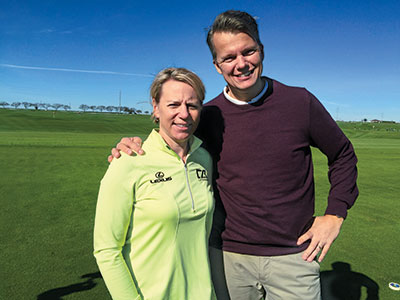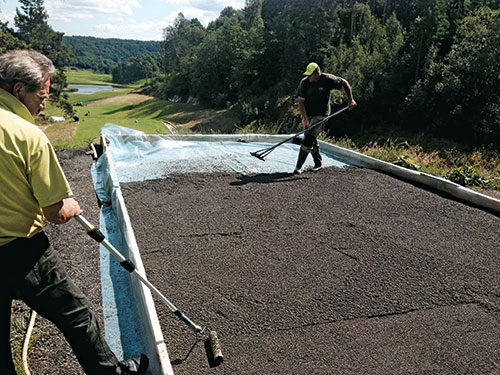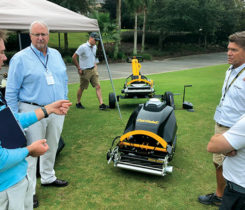Capitalizing on Capillary

Annika Sorenstam & Martin Sternberg
A new partnership has Capillary Concrete looking beyond bunkers and beyond golf.
It’s not often that “Ms. 59,” Annika Sorenstam, does anything halfway. But that’s exactly what the World Golf Hall of Famer did when she recently upped her ownership stake in Capillary Concrete. She is now a 50-percent owner of the sports base material company.
“Now that I’m in retirement, I find myself learning about concrete,” Sorenstam told Golfdom at the recent ANA Inspiration LPGA major in Rancho Mirage, Calif. “For me it is an interesting product — (Capillary Concrete) goes hand in hand with design, growing the game and environmental sustainability. It’s very exciting.”
Though watching concrete dry might not sound as exciting as what Sorenstam did in her playing days, the rapid growth of the company is something that would excite any investor. According to Capillary Concrete founder Martin Sternberg, CGCS, the company is doubling in size every six months. He expects the company to do as many bunkers in the United States in the first half of 2017 as the company did stateside in all of 2015 and 2016 combined.
Not bad for a company that already has done 4,000 bunkers worldwide in a relatively short time.
“I wake up and pinch my arm every morning,” Sternberg says. “I crossed the Atlantic 22 times last year for Capillary Concrete. We have 15 distributors worldwide now. Our biggest challenge is finding enough materials and people to help us.”
Capillary Concrete uses gravity and capillary force to keep water moving through bunkers and prevents washouts, plugged lies and keeps sand faces from failing, according to Sternberg, who founded the company in 2010. But now, thanks to the addition of Sorenstam, the company plans to expand.
“Once I started listening and seeing the product, I was intrigued by its possibilities,” Sorenstam says. “We can help limit injuries in sports fields by controlling the moisture under the surface where people fall. And in that market, we have no competitors — we’re just finalizing our testing to show that the proof is in the pudding.”
Sternberg is thankful for Sorenstam’s vision to move the company beyond the “small niche” of golf course bunkers and excitedly talks about “Head Injury Criterion” in sports turf, a measurement with which he was previously unfamiliar. Still, golf courses clearly have his heart. The expansion that excites him is tee box construction.
“We can save 85 percent irrigation in a year on a tee by using Capillary Concrete over gravel,” Sternberg says. “That’s a huge number in places like California and Arizona, where water is expensive and the restrictions are tough. It’s a huge opportunity.”

“We can save 85 percent irrigation in a year on a tee by using Capillary Concrete over gravel,” Sternberg says. “That’s a huge number in places like California and Arizona.”
Sternberg — who still holds the title of superintendent of a course he owns in his native Sweden — says it’s just a matter of time for them to perfect the technology to make it widely applicable.
“I’ve got tees (with Capillary Concrete) on my course in Sweden, where we get 35 inches of rain annually, that I’ve never irrigated,” he says. “I’ve built tees that can do without irrigation entirely, but that’s not how you do field testing. We’re working, looking for the right application for each and every area, warm season and cold season.”
Sustainability is a big part of the company’s credo, and Sternberg says it’s for good reason: He’s old.
“I’m an old guy — I was the first superintendent in Europe to get certified by the GCSAA back in 1992,” Sternberg says. “I’ve been a superintendent for over 30 years. I remember all the times, and it bugs the hell out of me that as a profession, an industry, we can’t seem to prove all the benefits (golf) has done for society as a whole. We get beaten up. Everyone has a perception, ‘Golf is just for the rich, they spray chemicals, use too much fertilizer.’ Nothing is further from the truth. Look at landscaping, sports turf and parks — we’re leading this technical revolution. Everything originated in golf. Golf is on the cutting edge of maintenance practices for everyone.”
Sorenstam comes to the bunker business foremost as a player, and knows the way she wants a bunker to play when she (rarely) hits in one. She says Sternberg has taught her more about bunkers than she thought she’d ever know.
“People are starting to see the benefits, not just from a maintenance standpoint, but from an environmentally friendly standpoint,” she says. “They’re seeing and recognizing the sustainability.”
Sternberg says he and Sorenstam make a good team. She’s famous and well organized. They’ve known each other a long time, and when she talks, people listen. Sternberg sees the company growing around the world, and not just at exclusive destination golf courses but also the mom and pop courses.
“We have big projects like TPC Sugarloaf — we’ll be there for two years getting all their bunkers done. Next week I’m heading to Top of the Rock in Missouri, an amazing place,” Sternberg says. “Those are the famous places with an abundance of money. My favorite projects are the local small-town courses. Those are the places where you can truly help people make their golf courses be more sustainable.”
Too much time in the sand
Check out this video interview with superintendents from around the country on their opinion on the current state of bunker maintenance.
Photos: Capillary concrete










